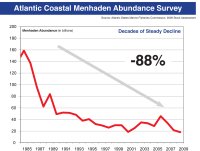.An ongoing study by the Chesapeake Bay Ecological Foundation (CBEF) determined that low numbers of Atlantic menhaden, the predominate striped bass prey species within the Chesapeake Bay and along the Atlantic coast, have affected the growth, health and migration of striped bass. Since 2004, the CBEF, with assistance from East Carolina University, has examined over 7,000 striped bass from the Chesapeake Bay and the Atlantic Ocean along the Virginia and North Carolina coast.
Data collected by this study indicates that malnutrition observed in 16” to 24” striped bass from Maryland’s section of the Chesapeake Bay (upper Bay) is a consequence of ecological depletion (insufficient numbers of young menhaden less than 10” and bay anchovy). Malnutrition is also exacerbated by low numbers of other forage species. CBEF studies of resident and migratory striped bass determined that in most years since 2005, menhaden constituted over 75% of their diet (by weight). Within the Chesapeake Bay, striped bass growth decreased, a significant percentage of striped bass have mycobacterial infections and striped bass natural mortality rates have risen.
Diminishing striped bass numbers culminated in threatened species status in the upper Bay in 1984 and a fishing moratorium in 1985. In 1990 the Atlantic States Marine Fisheries Commission (ASMFC), which is responsible for the management of menhaden and striped bass, partially reopened the fishery in state waters and in 1995 declared striped bass fully recovered. Within the upper Bay a harvest cap was imposed for the first time and the 14” minimum size was raised to 18” (4-5 years of age). This size limit protected more than 90% of immature female striped bass which historically emigrated to coastal waters and became ocean residents before reaching 18”; only re-entering the Chesapeake Bay on spring spawning migrations after reaching maturity at age 6 or older. Within ocean waters the minimum size was set at 28” to allow most females to spawn at least once before reaching harvest size. These actions resulted in a greatly expanded striped bass population, and intensified feeding on menhaden and adult bay anchovy in ocean waters.
During the early 1990s, coincidental with burgeoning striped bass predation on menhaden and bay anchovy, adult menhaden were severely overfished off New England concurrent with intensive fishing by the purse seine reduction fishery (large scale harvest of fish for processing into products such a fish oil and meal) in the Virginia section of the Chesapeake Bay (lower Bay) and in ocean areas from New Jersey to North Carolina. The Omega Protein Corporation currently owns and operates the only remaining menhaden reduction fishery. This fishery, the largest on the Atlantic coast, competes with striped bass, fish eating birds and many marine predators. During 2009 and 2010, approximately 500 million young, immature menhaden (less than 10”), about 43% of the total numbers landed, were harvested in the lower bay and nearby coastal waters by Omega Protein. These immature menhaden are crucial to the diet of the Bay’s malnourished 16” to 24” striped bass and are supposed to be protected according to ASMFC’s ecological objectives in their Interstate Fishery Management Plan for Atlantic Menhaden.
This study revealed that large numbers of striped bass greater than 28”, predominately females, which historically migrated from summer habitat in New England waters during the fall to feeding grounds in coastal ocean waters off Virginia and North Carolina, now arrive in the upper Bay during late fall and remain through the spring spawning season – a previously undocumented event. This study also documented a significant increase in the population of immature female striped bass in the upper Bay during October through December of 2010. These females represented 25% of striped bass in the 18” to 24” range; two times higher than the 12% average in 2008 & 2009 and four times higher than the 6% average in 2006 & 2007. Immature females in this size range normally inhabit ocean waters and are protected by the 28” minimum size limit. However, within the Chesapeake Bay, immature female striped bass greater than 18” can be harvested by recreational and commercial fisheries.
Diet analyses, body fat indices and the unprecedented shift in established feeding patterns by migratory striped bass indicate that menhaden and bay anchovy are severely depleted on their coastal feeding grounds. Consequently, migratory striped bass that over-winter in the Chesapeake Bay are competing with resident striped bass for menhaden of all sizes.
ASMFC decisions that address menhaden overfishing must also resolve the fundamental problem – ecological depletion of Atlantic menhaden in the Chesapeake Bay and Atlantic Ocean.


